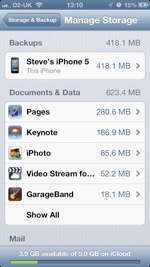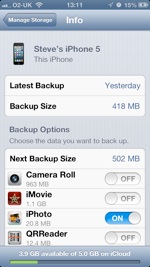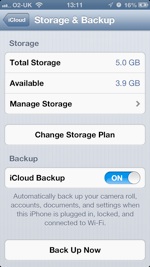iCloud Storage & Backup (sizes)
It appears that iCloud Storage & Backup is confusing a small number of users, particularly when trying to formulate what steps to take when their devices indicate there is not enough room to perform a back up.
The guide below is aimed at explaining the information provided by your device, so that the user can make an informed decision as to what steps to take to resolve situations where there is not enough room in iCloud for a back up.
1. Locating the iCloud storage information.








1. Locate and tap the settings button on your device.
2. Scroll down, locate and tap the iCloud listing in settings.
3. Scroll down, locate and tap the Storage & Backup listing in iCloud settings.
4. You should now see your Storage & Backup information.



2. Understanding the Basic iCloud Storage information.





3. Understanding Detailed iCloud Storage information.












4. Understanding iCloud Backup information.



5. Managing iCloud Storage.











